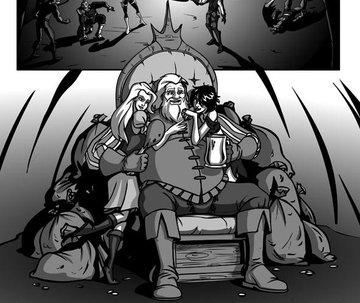Falstaff
Falstaff, King of Thieves, also known as John Oldcastle, is a high ranking member of Illuminati and is in charge of Acquisitions and Security for Eastcheap, working under the Society's Treasurer: Wyvern.
Contents
History
Born in 1936, John Oldcastle was a thief and a close friend of Mariah Monmouth. [1] He had also grown fond of her son, Harry and later, for unknown reasons, murdered Mariah. He took Harry in and raised and trained him to be a criminal. With his associate, Pistol, the three of them pulled jobs all over Sydney. ("Strangled")
Eventually, Harry left to pursue a career as an independent mercenary. Over the years, Oldcastle gained more infamy and recruited a gang of thieves. He took the name Falstaff, and was eventually recruited by the Illuminati to coordinate acquisitions for their treasury on Eastcheap Isle. ("Strangled", "Acquisitions")
When the Redemption Squad arrived at Eastcheap, Falstaff attempted to recruit them into the Illuminati, with the help of Fiona Canmore and Thailog. While the Squad feigned agreement, he was smart enough to not trust them. Fortunately for the Redemption Squad, Fang knew Falstaff was on to them, and they battled his gang. In the end, Falstaff submerged Eastcheap, escaping with the Illuminati's treasury. ("Losers")
Seven months later, in July 1997, Falstaff facilitated the acquisition of the Hand of Valmont from Thailog and Shahrizad. Unbeknownst to Wyvern and Falstaff, however, Thailog and Shahrizad had another errand in the works and used the visit as an opportunity to leave Eastcheap with the shaft of Gungnir. ("Acquisitions")
Characteristics
Like his larger-than-life namesake, Falstaff is big not only in terms of size, but in personality as well. In 1968, John Oldcastle's head, beard, and mustache were jet black, but now at sixty years old his hair has grown white. He is a strong adversary, able to snap out of Dingo's bolas right before he ordered Eastcheap to submerge. While he looks to be very fat, Greg Weisman has written that "it's mostly muscle like a sumo wrestler". [2]
Appearances
- "Strangled" (First Appearance)
- "Losers"
- "Acquisitions"
Real World Background
Falstaff is named after Sir John Falstaff, one of the leading characters of Shakespeare's Henry IV plays and one of Shakespeare's most popular comical figures. A fat old knight, Falstaff is the leader of the riotous crew whom Prince Hal befriends during his madcap youth. Falstaff is a thief and a heavy drinker, but is also extremely witty, with a gift for improbable exaggeration. For example, in Henry IV, Part 1, after Falstaff and his band rob a group of travelers at Gad's Hill, Prince Hal and one of his associates, Poins, attack the thieves in turn and steal their loot. Falstaff afterwards claims to have fought off his assailants – whose numbers grow dramatically with each line – until Hal tells him what really happened; Falstaff then claims that he had recognized his attacker's true identity and, as a loyal Englishman, had no desire to harm the heir apparent. Falstaff's exploits fill most of the plays until, in the final act of Henry IV, Part 2, Hal, now crowned king as Henry V, rejects the old knight and his crew. In Henry V, Falstaff dies off-stage, apparently of a broken heart (Mistress Quickly, who describes his death, states her belief that he has gone to "Arthur's bosom", presumably a slip for "Abraham's bosom" – the slip is appropriate in light of his Gargoyles Universe namesake's membership in the Illuminati, which has connections to King Arthur Pendragon).
Falstaff also appears in The Merry Wives of Windsor, though more as a buffoon than the wit of the Henry IV plays; the play could almost be considered the Falstaffian equivalent of The Goliath Chronicles (according to legend, Shakespeare only wrote it because Elizabeth I wanted to see Falstaff in love). Falstaff spends the play trying to woo the merry wives of the title, hoping to gain their money, only to be outwitted by them and humiliated throughout. (In an episode of The Spectacular Spider-Man, Aunt May and Anna Watson went to see a performance of the play – which was called on account of an attack from the Sinister Six. Greg Weisman has confirmed that this choice of play for the episode was inspired by his work on Falstaff in Gargoyles: Bad Guys at the time, and noting how much the character design for St. John Devereaux – the actor playing Falstaff in that performance – resembled the fat old knight.) [3]
Though Shakespeare's Falstaff is fictional, he is loosely based on John Oldcastle, a friend of Prince Hal's who converted to Lollardism (a form of proto-Protestantism that began in the late 14th century, founded by John Wycliffe), raised a rebellion early in Henry V's reign, was defeated, and executed for treason and heresy in 1417. Oldcastle's name was bestowed on one of Prince Hal's companions in the Elizabethan history play The Famous Victories of Henry the Fifth, though the character in the play has nothing in common with his historical namesake apart from the name and the association with Prince Hal. Shakespeare, when writing Henry IV, Part 1, adapted Oldcastle for his play, making him into the familiar comical figure. However, he later on changed the name (reportedly to avoid problems with Oldcastle's descendants) to "Falstaff". (Hence "John Oldcastle" as Falstaff's original name in Bad Guys.) Only a few traces of the original name remain in Henry IV Part 1, chief of which is a line of Prince Hal's in Act One, Scene Two, calling Falstaff "my old lad of the castle".
Shakespeare derived the name "Falstaff" from Sir John Fastolfe, a 15th century English knight. He was an able warrior, but had once been falsely accused of cowardice after he ordered a retreat at the Battle of Patay during the Hundred Years' War (the battle was already lost and Fastolfe had realized that withdrawing his troops was the only way to save them); Shakespeare had earlier included him as a minor character in one of his first history plays, Henry VI, Part 1 (portraying him as a coward there – though a straightforward, serious coward with no comical aspects).
Production Background
Since at least 2000, Greg Weisman had plans to feature Falstaff as an antagonist for Gargoyles: Bad Guys. [4][5]
See Also
- Falstaff at Wikipedia, the Free Encyclopedia


